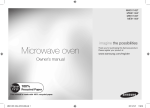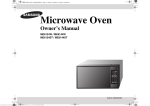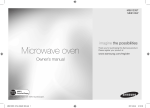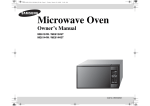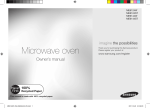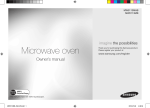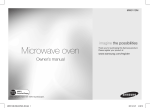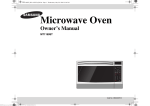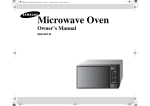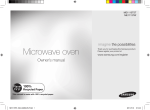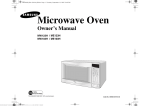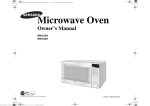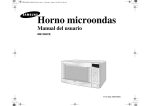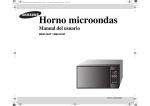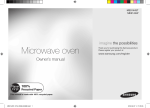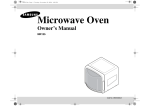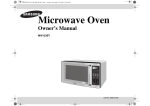Download Samsung 32L Capacity Stainless Steel (MW9114ST) User Manual
Transcript
t~`XX[z{zhTWZ^Y^hluUGGwGXGGt SGhGY[SGYWW`GGXXa[`Ght
Microwave Oven
Owner’s Manual
MW9114ST / MW9114W
Code No.: DE68-03727A
t~`XX[z{zhTWZ^Y^hluUGGwGYGGt SGhGY[SGYWW`GGXXa[`Ght
Content
Safety
Content................................................................................................ 2
Safety .................................................................................................. 2
Safety Precautions............................................................................. 3
Installing Your Microwave Oven....................................................... 4
How a Microwave Oven Works ......................................................... 4
Your New Microwave oven................................................................ 5
Checking Parts ................................................................................. 5
Warranty and Service Information.................................................... 5
Setting Up Your Microwave Oven .................................................... 5
Model: MW9114ST .......................................................................... 6
Model: MW9114W............................................................................ 6
Operation ............................................................................................ 7
Setting the Clock .............................................................................. 7
Using the Pause/Cancel Button ....................................................... 7
Using the One Minute + Button ........................................................ 7
Using the Sensor Cook Buttons ....................................................... 7
Sensor Cooking Guide ..................................................................... 7
Using the Instant Cook Buttons........................................................ 8
Using the Rice/Pasta Buttons .......................................................... 8
Using the Meat/Poultry Buttons........................................................ 9
Defrosting Automatically................................................................. 10
Reheating Automatically ................................................................ 10
Using the Auto Steam Cook Button (MW9114ST Only)................. 10
Setting Cooking Times & Power Levels ......................................... 12
Demonstration Mode ...................................................................... 12
Using the More/Less Buttons ......................................................... 12
Switching the Beeper On/Off.......................................................... 12
Using the Kitchen Timer ................................................................. 12
Setting the Child Protection Lock ................................................... 12
Cooking Instructions ....................................................................... 13
Cooking Utensils ............................................................................ 13
Cooking Techniques ...................................................................... 13
Auto Sensor Cook .......................................................................... 14
Cooking Guide ............................................................................... 14
Auto Defrosting Guide .................................................................... 15
Recipes .......................................................................................... 16
Appendix........................................................................................... 17
Troubleshooting Guide ................................................................... 17
Specifications ................................................................................. 18
IMPORTANT SAFETY INSTRUCTIONS.
READ CAREFULLY AND KEEP FOR FUTURE REFERENCE.
Before cooking food or liquids in your microwave oven, please check
that the following safety precautions are taken.
u
Important
Note
PRECAUTIONS TO AVOID POSSIBLE EXPOSURE TO
EXCESSIVE MICROWAVE ENERGY
Failure to observe the following safety precautions may result in harmful exposure to
microwave energy.
(a) Under no circumstances should any attempt be made to operate the oven with
the door open or to tamper with the safety interlocks (door latches) or to insert
anything into the safety interlock holes.
(b) Do not place any object between the oven door and front face or allow food or
cleaner residues to accumulate on sealing surfaces. Ensure that the door and
door sealing surfaces are kept clean by wiping after use first with a damp cloth
and then with a soft dry cloth.
(c) Do not operate the oven if it is damaged until it has been repaired by a
qualified microwave service technician trained by the manufacturer. It is
particularly important that the oven door closes properly and that there is no
damage to the:
(1) Door (bent)
(2) Door hinges (broken or loose)
(3) door seals and sealing surfaces
(d) The oven should not be adjusted or repaired by anyone other than a properly
qualified microwave service technician trained by the manufacturer.
WARNING:
If the door or door seals are damaged, the oven must not be operated until it has been
repaired by a competent person.
WARNING:
It is hazardous for anyone other than a comperent person to carry out any service or
repair operation which involves the removal of a cover which gives protection against
exposure to microwave energy.
WARNING:
Liquids and other foods must not be heated in sealed containers since they are
liable to explode.
WARNING:
Only allow children to use the oven without supervision when adequate instructions
have been given so that the child is able to use the oven in a safe way and
understands the hazards of improper use.
WARNING:
When the appliance is operated in the combination mode, children should only use the
oven under adult supervision due to the temperatures generated.
WARNING:
Accessible parts may become hot during use. Young children should be kept
away.
• For your safety, do not use high-pressure water cleaners or steam jet
cleaners.
2
t~`XX[z{zhTWZ^Y^hluUGGwGZGGt SGhGY[SGYWW`GGXXa[`Ght
Safety Precautions
•
•
Only use utensils that are suitable for use in microwave ovens;
DO NOT use any metallic containers, Dinnerware with gold or silver
trimmings, Skewers, forks, etc.
Remove wire twist ties from paper or plastic bags.
Reason: Electric arcing or sparking may occur and may damage the oven.
• When heating food in plastic or paper containers, keep an eye on the oven
due to the possibility of ignition;
• If smoke is observed, switch off or unplug the appliance and keep the door
closed in order to stifle any flames.
• Microwave heating of beverages can result in delayed eruptive boiling,
therefore care must be taken when handling the container; To prevent this
situation ALWAYS allow a standing time of at least 20 seconds after the oven
has been switched off so that the temperature can equalize.
Stir during heating, if necessary, and ALWAYS stir after heating.
In the event of scalding, follow these FIRST AID instructions:
* Immerse the scalded area in cold water for at least 10 minutes.
* Cover with a clean, dry dressing.
* Do not apply any creams, oils or lotions.
• The contents of feeding bottles and baby food jars shall be stirred or shaken
and the temperature checked before consumption, in order to avoid burns;
• The oven should be cleaned regularly and any food deposits removed.
• Failure to maintain the oven in a clean condition could lead to deterioration of
the surface that could adversely affect the life of the appliance and possibly
result in a hazardous situation.
• The microwave oven is intended to be used on the counter or counter top use
only, the microwave oven shall not be placed in a cabinet.
• The appliance is not intended for use by persons (including children) with
reduced physical, sensory or mental capabilities, or lack of experience and
knowledge, unless they have been given supervision or instruction concerning
use of the appliance by a person responsible for their safety.
• Children should be supervised to ensure that they do not play with the
appliance
• The appliance is not intended for installing in road vehicles, caravans and
similar vehicles etc.
• If the supply cord is damaged, it must be replaced by the manufacturer, its
service agent or similarly qualified persons in order to avoid a hazard.
• Group 2 ISM equipment: group 2 contains all ISM equipment in which radiofrequency energy is intentionally generated and/or used in the form of
electromagnetic radiation for the treatment of material, and EDM and arc
welding equipment.
• Class B equipment is equipment suitable for use in domestic establishments
and inestablishments directly connected to a low voltage power supply
network which supplies buildings used for domestic purposes.
• When moving heating elements, make sure to use the equipment designed to
move heating element while wearing safety gloves provided with the product,
and see if temperature drops sufficiently (at least 10 minutes after grill or
combination cooking operation) after operation.
• During use the appliance becomes hot. Care should be taken to avoid
touching heating elements inside the oven.
DO NOT use harsh abrasive cleaners or sharp metal scrapers to clean the
oven door glass since they can scratch the surface, which may result in
shattering of the glass
• appliances are not intended to be operated by means of an external timer or
separate remote-control system.
• ALWAYS use oven gloves when removing a dish from the oven to avoid
unintentional burn.
• DO NOT touch heating elements or interior oven walls until the oven be
cooled down.
• DO NOT immerse the power cable or plug in water and keep the power cable
away from heated surfaces.
DO NOT operate this appliance if it has a damaged power cable or plug.
• Stand at arms length from the oven when opening the door.
Reason: The hot air or steam released may cause scalding.
• You may notice a Clicking sound during operation(especially when the oven is
defrosting).
Reason: This sound is normal when the electrical power output is changing.
• DO NOT operate the microwave oven when it is empty. The power will be cut
off automatically for safety. You can operate normally after letting it stand for
over 30 minutes.
It is best to leave a glass of water inside the oven at all times.The water will
absorb the microwaves energy if the oven accidently started.
• Young children should NEVER be allowed to use or play with the microwave
oven. Nor should they be left unattended near the microwave oven when it is
in use. Items of interest to children should not be stored or hidden just above
the oven.
• Children should be supervised to ensure that they do not play with the
appliance.
• Small amounts of food require shorter cooking or heating time. If normal times
are allowed they may overheat and burn.
• NEVER fill the container to the top and choose a container that is wider at the
top than at the bottom to prevent the liquid from boiling over. Bottles with
narrow necks may also explode if overheated.
NEVER heat a babys bottle with the teat on, as the bottle may explode if
overheated.
Please recycle or dispose of the packaging material for this product in an environmentally responsible manner.
Please contact your local authorities in regard to the enviromentally safe disposal of this product.
3
t~`XX[z{zhTWZ^Y^hluUGGwG[GGt SGhGY[SGYWW`GGXXa[`Ght
Installing Your Microwave Oven
How a Microwave Oven Works
Place the oven on a flat level surface 85cm above the
floor. The surface should be strong enough to safety
bear the weight of the oven.
Cooking Principle
20cm
above
10cm
behind
10cm
on the side
1. The microwaves generated by the magnetron are
distributed uniformly as the food rotates on the
turntable. The food is thus cooked evenly.
2. The microwaves are absorbed by the food up to a
depth of about 1 inch (2.5 cm). Cooking then continues
as the heat is dissipated within the food.
3. Cooking times vary according to the container used
and the properties of the food:
• Quantity and density
• Water content
• Initial temperature (refrigerated or not)
1. When you install your oven, make sure there is adequate
ventilation for your oven by leaving at least 10 cm (4
inches) of space behind and, on the sides of the oven
and 20 cm (8 inches) of space above.
2. Remove all packing materials inside the oven.
Install the roller ring and turntable.
Check that the turntable rotates freely.
3. This microwave oven has to be positioned so that plug is
accessible.
If the supply cord is damaged, it must be replaced by a special
cord or assembly available from the manufacturer or its service
agent.
For your personal safety, plug the cable into a 3-pin, 240 Volt,
50Hz, AC earthed socket. If the power cable of this appliance is
damaged, it must be replaced by a special cable.
Do not install the microwave oven in hot or damp surroundings
like next to a traditional oven or radiator. The power supply
specifications of the oven must be respected and any extension
cable used must be of the same standard as the power cable
supplied with the oven. Wipe the interior and the door seal with a
damp cloth before using your microwave oven for the first time.
4
As the centre of the food is cooked by heat dissipation, cooking continues
even when you have taken the food out of the oven. Standing times specified
in recipes and in this booklet must therefore be respected to ensure:
• Even cooking of the food right to the centre
• The same temperature throughout the food
t~`XX[z{zhTWZ^Y^hluUGGwG\GGt SGhGY[SGYWW`GGXXa[`Ght
Your New Microwave oven
Your New Microwave oven
Checking Parts
Setting Up Your Microwave Oven
Unpack your microwave oven and check to make sure that you have all the parts
shown here. If any part is missing or broken, call your dealer.
1.
Place the oven on a flat, sturdy surface and plug the cord into a grounded outlet.
once plugged in, the display on your oven will show:
kg
Microwave oven
Turntable
Coupler
g
Oz.
Lbs. QTY.
Make sure there is adequate ventilation for your oven by leaving at least four
inches of space behind, above, and to the side of the oven.
2. Open the oven door by pulling on the handle.
3. Wipe the inside of the oven with a damp cloth.
4. Place the pre-assembled ring in the indentation in the center of the oven.
Roller guide ring
5.
Power steam cooker
(MW9114ST Only)
Warranty and Service Information
When contacting Samsung, please provide the specific model and serial number information which is usually located on the back or bottom of the product. Please record
these numbers below, along with the other requested information. Keep this information in a safe place as a permnent record of your purchase to aid in identification in
case of theft or loss, and a copy of your sales receipt as a proof of purchase if waranty
service is needed.
MODEL NUMBER ____________________
SERIAL NUMBER ____________________
DATE PURCHASED ____________________
PURCHASED FROM ____________________
Warranty service can only be performed by a Samsung Authorized Service Center. If
you should require warranty service, provide the above information with a copy of your
sales receipt to the Samsung Authorized Service Center.
5
Place the glass tray on top of the ring so that the three glass tabs in the center of
the tray fit securely into the tabs on the floor of the oven. )
t~`XX[z{zhTWZ^Y^hluUGGwG]GGt SGhGY[SGYWW`GGXXa[`Ght
Your New Microwave oven
Model: MW9114ST
Model: MW9114W
8
9
1
1
2
2
3
3
10
11
4
8
9
4
5
10
5
12
1.
2.
3.
4.
5.
6.
7.
8.
11
6
13
6
12
7
14
7
13
Clock
One Touch Sensor Cook
Buttons
Auto Cook Menus
Auto Reheat
Number Button
Power Level
Pause/Cancel
One Minute +
9.
10.
11.
12.
13.
14.
Sound
Auto Steam Cook
Auto Defrost
More/Less
Kitchen Timer
Start
1.
2.
3.
4.
5.
6.
7.
8.
6
Clock
One Touch Sensor Cook
Buttons
Auto Cook Menus
Auto Reheat
Number Button
Power Level
Pause/Cancel
One Minute +
9.
10.
11.
12.
13.
Sound
Auto Defrost
More/Less
Kitchen Timer
Start
t~`XX[z{zhTWZ^Y^hluUGGwG^GGt SGhGY[SGYWW`GGXXa[`Ght
Operation
Setting the Clock
Using the One Touch Sensor Cook Buttons
When power is supplied, “12:00” is automatically displayed on the display. Please set
the current time.
1. Press the Clock button.
2. Use the number buttons to enter the current time. You must press at least three
numbers to set the clock. If the current time is 5:00 enter, 5,0,0.
3. When 5 seconds has elapsed, “ENTER” indicator flash and “Cloc” will be
displayed.
4. Press Clock again. A colon will blink, indicating that the time is set.
If there is a power interruption, you will need to reset the clock.
You can check the current time while cooking is in progress by pressing the
Clock button.
By actually sensing the steam that escapes as food heat, this feature automatically
adjusts the oven’s heating time for various types and amounts of precooked food. All
food should be precooked and at refrigerator temperature.
1. Press the Sensor Cook button corresponding to the food you are cooking
(Popcorn, for example). The display shows “
” and your microwave oven
will begin cooking automatically.
When cooking popcorn, wait at least five minutes between each bag to avoid
overheating the glass tray. If you want to check the current time while cooking is in
progress, press the Clock button.
Using the Pause/Cancel Button
•
Sensor Cooking Guide
The Pause/Cancel button allows you to clear instructions you have entered. It also
allows you to pause the oven’s cooking cycle, so that you can check the food.
• To pause the oven during cooking: press Pause/Cancel once. To restart, press
Start.
• To stop cooking, erase instructions, and return the oven display to the time of day:
press Pause/Cancel twice.
• To correct a mistake you have just entered: press Pause/Cancel once, then reenter the instructions.
Follow the instructions below when sensor cooking different types of food.
Food
7
Procedure
Popcorn
85g - 100g
1 package
Use only one microwave-only bag of popcorn at a time.
Use caution when removing and opening hot bag from
oven. Let oven cool for at least 5 minutes before using
again.
Baked
Potatoes
1 to 6 EA.
Prick each potato several times with fork. Place on
turntable in spoke-like fashion. Let stand 3-5 min. Let
oven cool for at least 5 minutes before using again.
Fresh
Vegetables
1 to 4 cups Place fresh vegetables in microwave-safe dish and add
Using the One Minute + Button
This button offers a convenient way to heat food in one minute increments at the High
power level.
1. Press the One Minute+ button once for each minute you wish to cook the food.
For example, press it twice for two minutes. The time will display, and the oven
starts automatically.
Add minutes to a program in progress by pressing the One Minute+ button for
each minute you want to add.
Amount
2 Tbsp of water. Cover with microwave safe plastic wrap
or lid. (Using the glass cover gives the best results.)
If using plastic wrap be sure to leave a small opening
near the edge of dish for ventilation. Remove vegetable
from oven let sit covered for 2 minutes, stir or serve. Let
oven cool for at least 5 minutes before using again.
t~`XX[z{zhTWZ^Y^hluUGGwG_GGt SGhGY[SGYWW`GGXXa[`Ght
Operation
Using the Instant Cook Buttons
Rice/Pasta Chart
1. Press the Instant Cook button corresponding to the food you are cooking
(Beverage, for example). The display shows the first serving size. (“ENTER” and
“QTY.” will flash):
2. Press the button repeatedly to select the serving size you want. The display will
cycle through all available serving sizes. Once you select the correct serving size,
the microwave will begin cooking automatically.
When the cooking time is over, the oven will beep. The oven will then beep every
minute.
Code
Item
Weight
A-1
Pizza reheat
1 Slice
2 Slices
3 Slices
4 Slices
•
½ cup
1 cup
2 cups
•
A-2
Beverage
Code
A-1
Item
White
Rice
Initial
Weight Temperature
1-2
serves
Remarks
Rice:Room Wash rice with cold water until water runs clear. Place the
Water:Room rice and water in a microwave-safe rice cooker or round
glass Pyrex dish with a lid and after cooking allow rice to
stand without removing lid. Stand rice for 3-5 minutes and
stir to separate grains.
1 Serv.
Remarks
•
•
•
•
A-2
Put the pizza on a microwave-safe plate
with wide end of slice towards the
outside edge of the plate.
Do not let slices overlap. Do not cover.
Before serving, let stand 1-2 min.
Dry Pasta
1-2
serves
Water:
60 °C tap
water
100g
200g
250ml
375ml
Place dry pasta into microwave-safe rice coo-ker or bowl
or round Glass Pyrex dish breaking if necessary to fit without lids on and cook uncovered. After cooking put on
lid, allow standing time of 2-5 minutes. Stir and serve.
1 Serv.
Use measuring cup or mug ; do not
cover.
Place the beverage in the oven.
After heating, stir well.
A-3
Frozen
Pasta
1-2
serves
Water:
60 °C tap
water
100g
200g
3cups
5cups
Place frozen pasta into microwave-safe rice cooker or bowl
or round Glass Pyrex dish without lids on and cook
uncovered.
After cooking put on lid, allow standing time of 2-5 minutes.
Stir and serve.
1. Press the Rice/Pasta button corresponding to the food you are cooking. The
A-4
Fresh
Pasta
1-2
serves
Water:
60 °C tap
water
Pasta
1 Serv.
125g
2 S erv.
250g
Water
3cups
5cups
Place fresh pasta into microwave-safe rice cooker or bowl
or round Glass Pyrex dish without lids on and cook
uncovered.
After cooking put on lid, allow standing time of 2-5 minutes.
Stir and serve.
1 Serv.
A-5
Spaghetti
1-2
serves
Water:
60 °C tap
water
A-7
8
2 Minute
Noodles
Porridge
1-3
serves
1-2
serves
2 S erv.
Pasta
125g
250g
Water
3cups
5cups
Place dry spaghetti into microwave-safe rice cooker or
bowl or round Glass Pyrex dish breaking if necessary to fit
- without lids on and cook uncovered. After cooking put on
lid, allow standing time of 2-5 minutes. Stir and serve.
1 Serv.
A-6
2 S erv.
Pasta
Water
Using the Rice/Pasta Buttons
display shows “A-1”(item code).
Press the Rice/Pasta button repeatedly to select the item you want.(Refer to the
Rice/Pasta Chart below)
2. Press the Number 1 or 2 , 3 button to select the serving size you want.
(Refer to the Rice/Pasta Chart below for the serving)
Press Start button to begin cooking.
2 S erv.
Rice
Water
2 S erv.
Spaghetti
100g
200g
Water
3cups
5cups
Water:
Break noodle cake and place into a microwave-safe large
boiling water bowl. Pour boiling water over noodles and cook
uncovered. After oven beeps at half cooking time, stir well
and press start to continue. After cooking and then
standing time of two minutes, stir and serve.
1 Serv.
2 Serv.
3 ser v.
Noodle
1 packet
2 pac kets
3 pac kets
Wa ter
500 m l
1000 ml
1500 ml
Porridge oats: Place dry porridge oats and water or milk in a microwave
Room
safe bowl and cook uncovered. After oven beeps, stir the
oats well and press start to continue. After cooking, stir
Water&milk: well and top with brown sugar or honey.
Cold
1 Serv.
2 S erv.
Oats
35g
70g
Wa ter & Milk
150 m l
300ml
t~`XX[z{zhTWZ^Y^hluUGGwG`GGt SGhGY[SGYWW`GGXXa[`Ght
Operation
Using the Meat/Poultry Buttons
1. Press the Meat/Poultry button corresponding to the food you are cooking. The
display shows “A-1”(item code).
Press the Meat/Poultry button repeatedly to select the item you want.(Refer to
the Meat/Poultry Chart below)
2. Press the Number 1 or 2 , 3 button to select the serving size you want.
(Refer to the Meat/Poultry Chart below for the serving)
3. Press Start button to begin cooking.
Code
A-5
Item
Meatball
Weight
1 dish
Meat/Poultry Chart
Code
Item
Weight
Initial
Temperature
Chicken
Wings
A-2
Chicken
Nuggets
4 PCS
8 PCS
Refrigerated Put a paper on top of plate and arrange
nuggets in spoke fashion on paper towel.
Do not cover. Let stand 1 min.
A-3
Casserole
1 dish
Refrigerated Ingredients For casserole.
2 medium carrots(85g to 110g Before
peeling), 2 medium onions( 110 g to 140 g.
Before peeling), 2 medium potatoes(165 g
to 195 g before peeling), 450 ground chuck
beef, ½ teaspoon salt, ¼ cup water, 1/8
teaspoon pepper.
4-5 PCS Refrigerated Place wings around plate, spoke-fashion.
8-10 PCS
Cover with wax paper.
A-6
Bacon
Refrigerated Ingredients For Meat Balls.
450 g ground beef, ¼ cup chopped onion, 1
egg beaten, 1 teaspoon salt, ¼ teaspoon
pepper and 2 tablespoons water.
Meat Loaf
1 dish
Refrigerated Ingredients For meat loaf.
675 g ground chuck beef, ½ cup fine dry
bread crumbles, ¼ cup chopped onion, ½
cup chopped green pepper, 1 cup milk, 1
egg, 2 tablespoons ketchup, ¼ teaspoon
pepper, ¼ teaspoon salt.
Combine all ingredients: mix well. Pack
meat mixture firmly in loaf dish: smooth out
top. Cover with plastic wrap, turning back
one corner about 2 inches to vent. Place in
oven parallel to front of oven.
After cooking stand casserole for 5
minutes. Serve
Peel and slice vegetables into 1/8 inch thick
slices, Form beef into 12 small, flat pattie
using the 2-inch Reynolds Brass Ring.
Flatten patties. In 2-quart casserole, layer
half of beef patties, half of carrots, half of
onions, and half of potatoes. Sprinkle with
salt and pepper. Repeat layers, making
sure that top layer of beef patties is
completely covered with vegetables. Add
water. Press layer down into casserole.
Cover. After cooking stand casserole for 5
minutes. Serve.
A-4
Remarks
Combine all ingredients and mix well.
Shape into 20 x (25mm) meat balls. Place
meat balls in utensil. Cover with microwave
cling wrap turning back one corner of the
wrap by about 50mm to vent. Cook. After
cooking, stand meat balls for 5 minutes.
Serve.
Remarks
A-1
Initial
Temperature
A-7
Ham
Omelette
1 dish
Refrigerated Ingredients For Ham Omelette.
3 med. sized eggs, 1 tomato, 30 g chopped
ham, 2 tablespoons milk, herbs & Spices.
Beat eggs, add ham, 2 tablespoons milk,
herbs and spices. Cut tomato in cubes add
to mix plus 50g grated cheese. After oven
beeps, stir well and press start to continue.
After cooking stand for 2 minutes. Serve.
100-125 g Refrigerated Select fresh bacon rashers from your
200-225 g
butcher, deli or supermarket. Place on the
300-325 g
absorbent paper towel on microwave-safe
plate or Pyrex dish and cover with another
piece of paper towel and cook. Serve.
9
t~`XX[z{zhTWZ^Y^hluUGGwGXWGGt SGhGY[SGYWW`GGXXa[`Ght
Operation
Defrosting Automatically
Using the Auto Steam Cook Button (MW9114ST Only)
To thaw frozen food, set the weight of the food and the microwave automatically sets
the defrosting time, power level and standing time.
1. Press the Auto Defrost button. The display shows “1”.
(“ENTER” and “kg” will flash).
2. To set the type of your food, press the Auto Defrost button repeatedly. You can
also use the number buttons to enter the weight of the food directly.
It is possible to set up to a maximum of 2 kg(except to bread).
3. Press the Start button. The display will show cooking time during defrosting, the
oven will beep to let you know to turn the food over.
4. Open the oven door, and turn the food over.
5. Press the start button to resume defrosting.
With the steam feature, the cooking time is set automatically.
You can adjust the number of servings by pressing the Auto Steam Cook buttons.
1. Select the type of food that you are cooking by pressing the Auto Steam Cook
button once or more times.
2. Select the size of the serving by pressing the Auto Steam Cook button.
3. Press the Start button.
Result : Cooking starts. When it has finished.
1) The oven beeps four times.
2) The end reminder signal will beep 3 times (once every minute)
3) The current time is displayed again.
u
Power steam cooking hint.
• See page 15 for the Auto Defrosting Guide.
Reheating Automatically
Components of Steam Cooker
To reheat food, select the type of dish and the number of servings you want to reheat,
and the microwave automatically sets the reheating time.
1. Press the Auto Reheat button repeatedly to select the type of dish you wish to
reheat. The initial serving size for each dish is one serving.
You can select up to four cups for casseroles and pasta, Rice tinned reheat. Only
one serving is available for a plate of food.
The display shows the dish and quantity you have chosen.
2. Use the number buttons to increase the serving size. For example, for three
Bowl
servings, press the 3 button(Refer to the Auto Reheat Chart
below for the servings). The display shows the number of servings you
Basket
Lid
Handling of Steam Cooker
have selected:
3. Press the Start button. The display will show Cooking Time.
Auto Reheat Chart
Item
Plate of food
Code
Weight
A-1
1 serving
Remarks
•
•
•
Casserole
A-2
Pasta
A-3
Rice
A-4
Tinned Soup
A-5
*1-4 Cups
•
•
•
+
Use only pre-cooked, refrigerated
foods.
Cover plate with vented plastic wrap or
wax paper.
Contents
- 85-110 g meat, poultry or fish
( up to 170 g with bone)
- ½ cup starch
(potatoes, pasta, rice, etc.)
- ½ cup vegetables
(about 85-110 g)
(Bowl + lid)
Use only refrigerated foods.
Cover with lid or vented plastic wrap.
Stir foods well before serving.
* 1 cup = 1 serving
10
(Bowl with + Basket + lid)
t~`XX[z{zhTWZ^Y^hluUGGwGXXGGt SGhGY[SGYWW`GGXXa[`Ght
Operation
Auto Steam Cook Chart
Code
A-1
A-2
A-3
A-4
A-5
Item
Serving
Size
Standing
Time
Manual Steam Cook Chart
Handling
Recommendations
Steam
100-150 g 1-2 min. Bowl with
Vegetables 200-250 g
basket + lid
300-350 g
2-5 tbsp.
400-450 g
water
500-550 g
depending
on quantity
Weigh the vegetables after
washing, cleaning and cutting
into similar size.
Insert basket into the bowl of
steamer. Distribute vegetables
on the tray.
Add 30 ml (2 tablespoons)
water, when steaming 100350 g, add 45 ml (3
tablespoons) for 500-550 g.
Cover with lid.
Sea Food
100-150 g 2-3 min. Bowl with
200-250 g
basket + lid
300-350 g
400-450 g
Rinse and prepare fresh sea
food and sprinkle with lemon
juice. Add 100 ml into the bowl
of steamer. Put the food side
by side into the basket, insert
basket into bowl and cover
with lid.
100-150 g 2-3 min. Bowl with
200-250 g
basket + lid
300-350 g
+ 100ml
400-450 g
water
100-150 g 2-3 min.
200-250 g
300-350 g
400-450 g
500-550 g
600-650 g
Fish Fillets
Peeled
Potatoe
Chicken
Breast
Bowl + lid
100-150 g 2-3 min. Bowl with
200-250 g
basket + lid
300-350 g
+100ml
400-450 g
water
Food
Artichokes
Portion
Power
300 g High(0)
(1-2pcs)
Time Standing
Time Handling
(min.) (min.)
Instructions
5-6
1-2
Bowl + lid Rinse and clean artichokes.
Put into bowl. Add one
tablespoon lemon juice.
Cover with lid.
Fresh
Vegetables
300 g
High(0)
4-5
1-2
Bowl with Weigh the vegetables (e.g.
basket + broccoli florets, cauliflower
florets, carrots, pepper)
lid
after washing, cleaning and
cutting into similar size. Put
basket into bowl. Distribute
vegetables in basket. Add 2
tablespoons water. Cover
with lid.
Frozen
Vegetables
300 g
Medium
-High(7)
7-9
2-3
Bowl with Put the frozen vegetables
basket + into the basket in bowl. Add
1 tablespoon water.
lid
Cover wit lid.
Stir well after cooking and
standing.
Rinse and prepare fresh fish
fillets and sprinkle with lemon
juice. Add 100 ml into the bowl
of the steamer. Put fillets side
by side into the basket, insert
basket into bowl and cover
with lid.
Fresh Fish
fillets
300 g
1. stage:
High(0)
2. stage:
Medium
(5)
1-2
1-2
Bowl with Rinse and prepare fish
basket + fillets, such as Pollack, rose
fish or salmon. Sprinkle with
lid
lemon juice. Put basket into
bowl.
Add fillets side by side. Add
100 ml cold water. Cover
with lid.
Weigh the potatoes after
peeling, washing and cutting
into similar size. Put them into
the bowl of steamer. Add 1530 ml (1-2 tablespoons) water
when steaming 100-350g, add
45-60 ml (3-4 tablespoons) for
400-650 g. Cover with lid.
Chicken
Breast
1.stage:
High(0)
2. stage:
Medium
-High(7)
1-2
1-2
Bowl with Rinse and chicken breasts.
basket + Cut surface 2-3 times with a
knife. Put basket into bowl.
lid
Add chicken breasts side by
side.
Add 100ml cold water.
Cover with lid.
Rinse and prepare chicken
breasts.
Cut surface of breasts with a
knife 2-3 times. Add 100 ml
into the bowl of steamer. Put
breasts side by side into the
basket, insert basket into bowl
and cover with lid.
11
300 g
5-6
7-8
Jacket
Potatoes
500 g
High(0)
6-8
2-3
Bowl + lid Weigh and rinse the
potatoes and put them into
bowl. Add 3 tablespoons
water.
Cover with lid.
Stew
(chilled)
400 g
Medium
-High(7)
5-6
1-2
Bowl + lid Put stew into the bowl.
Cover with lid.
Stir well before standing.
Fruit
Compote
250 g
High(0)
3-4
2-3
Bowl + lid Weigh the fresh fruits (e.g.
apples, pears, plums,
apricots, mangoes or
pineapple) after peeling,
washing and cutting into
similar sizes or cubes. Put
into bowl.
Add 1-2 tablespoons water
and 1-2 tbsp. sugar. Cover
with lid.
t~`XX[z{zhTWZ^Y^hluUGGwGXYGGt SGhGY[SGYWW`GGXXa[`Ght
Operation
Setting Cooking Times & Power Levels
Using the More/Less Buttons
Your microwave allows you to set up to two different stages of cooking, each with its own
time length and power level. The power level button lets you control the heating intensity
from Warm (1) to High (0).
The More/Less buttons allow you to adjust pre-set cooking times. They only work in the
Rice/Pasta, Meat/Fish, Snack Bar, Auto Reheat,
Pizza Reheat, Beverage or Time Cook, Kitchen Time modes. Use the More/Less button only after you have already begun cooking with one of these procedures.
The More/Less feature cannot be used with the Sensor Cook button.
The More/Less key cannot be used with the Auto defrost key.
1. To ADD more time to an automatic cooking procedure: Press the More(9) button.
2. To REDUCE the time of an automatic cooking procedure: Press the Less(1) button.
If you wish to increase/decrease in Time Cook, Kitchen Time mode by 10sec,
press the More(9) or Less(1) button.
One-stage Cooking
For simple one-stage cooking, you only need to set a cooking time. The power level is automatically set to High. If you want to set the power to any other level, you must set it using the
Power Level button.
1. Use the number buttons to set a cooking time. You can set a time from one second to
99 minutes, 99 seconds. To set a time over one minute, enter the seconds too. For
example, to set 20 minutes, enter 2, 0, 0, 0 .
2. If you want to set the power level to something other than High, press the Power Level
button, then use the number buttons to enter a power level.
Switching the Beeper On/Off
Power Levels:
You can switch the beeper off whenever you want.
1 = PL:10
(Warm)
6 = PL:60
(Simmer)
2 = PL:20
(Low)
7 = PL:70
(Medium High)
3 = PL:30
(Defrost)
8 = PL:80
(Reheat)
4 = PL:40
(Medium Low)
9 = PL:90
(Sauté)
5 = PL:50
(Medium)
0 = PL:Hi
(High)
3. Press the Start button to begin cooking. If you want to change the power level, press
Pause/Cancel before you press Start, and re-enter all of the instructions.
Some recipes require different stages of cooking at different temperatures. You can set multiple stages of cooking with your microwave.
1. Press the Sound button. The display shows “ON”.
(“START” will flash)
2. Press the Sound button to turn the volume off. The display shows: “OFF”.(“START”
will flash)
3. Press Start. The display returns to the time of day.
Using the Kitchen Timer
1.
2.
3.
4.
Multi-stage Cooking
1. Follow steps 1 and 2 in the “One-Stage Cooking” section on the previous page.
When entering more than one cooking stage, the Power Level button must be
pressed before the second cooking stage can be entered.
To set the power level at High for a stage of cooking, press the Power Level button
twice.
2. Use the number buttons to set a second cooking time.
3. Press the Power Level button, then use the number buttons to set the power level of
the second stage of cooking.
4. Press Start to begin cooking.
You can check the Power Level while cooking is in progress by pressing the Power Level
button.
Press the Kitchen Timer button.
Use the Number buttons to set the length of time you want the timer to run.
Press Start to begin Kitchen Timer.
The display counts down and beeps when the time has elapsed.
Note: The microwave does not turn on when the Kitchen timer is used.
Setting the Child Protection Lock
You can lock your microwave oven so it can’t be used by unsupervised children.
1. Hold the “0” button and then press the “2” button. The display shows “Loc”.
At this point, the microwave oven cannot be used until it is unlocked. To unlock it,
repeat step 1 above.
Demonstration Mode
You can use the Demonstration Mode to see how your microwave oven operates without the
oven heating.
1. Hold the 0 button and then press the 1 button.
To turn demo mode off, repeat step 1 above.
12
t~`XX[z{zhTWZ^Y^hluUGGwGXZGGt SGhGY[SGYWW`GGXXa[`Ght
Cooking Instructions
Cooking Utensils
Cooking Techniques
Recommended Use
•
•
•
•
•
•
•
Stirring
Glass and glass-ceramic bowls and dishes — Use for heating or cooking.
Microwavable browning dish — Use to brown the exterior of small items such
as steaks, chops, or pancakes. Follow the directions provided with your browning
dish.
Microwavable plastic wrap — Use to retain steam. Leave a small opening for
some steam to escape and avoid placing it directly on the food.
Wax paper — Use as a cover to prevent spattering.
Paper towels and napkins — Use for short-term heating and covering; they
absorb excess moisture and prevent spattering. Do not use recycled paper towels,
which may contain metal and can catch fire.
Paper plates and cups — Use for short-term heating at low temperatures. Do
not use recycled paper, which may contain metal and can catch fire.
Thermometers — Use only those labeled “Microwave Safe” and follow all
directions. Check the food in several places. Conventional thermometers may be
used once the food has been removed from the oven.
Stir foods such as casseroles and vegetables while cooking to distribute heat evenly.
Food at the outside of the dish absorbs more energy and heats more quickly, so stir
from the outside to the center. The oven will turn off when you open the door to stir your
food.
Arrangement
Arrange unevenly shaped foods, such as chicken pieces or chops, with the thicker,
meatier parts toward the outside of the turntable where they receive more microwave
energy. To prevent overcooking, place thin or delicate parts toward the center of the
turntable.
Shielding
Shield food with narrow strips of aluminum foil to prevent overcooking. Areas that need
shielding include poultry wing-tips, the ends of poultry legs, and corners of square baking dishes. Use only small amounts of aluminum foil. Larger amounts can damage your
oven.
Turning
Limited Use
•
•
•
•
Turn foods over midway through cooking to expose all parts to microwave energy. This
is especially important with large items such as roasts.
Aluminum foil — Use narrow strips of foil to prevent overcooking of exposed
areas. Using too much foil can damage your oven, so be careful.
Ceramic, porcelain, and stoneware — Use these if they are labeled
“Microwave Safe”. If they are not labeled, test them to make sure they can be used
safely. Never use dishes with metallic trim.
Plastic — Use only if labeled “Microwave Safe”. Other plastics can melt.
Straw, wicker, and wood — Use only for short-term heating, as they can be
flammable.
Standing
Foods cooked in the microwave build up internal heat and continue to cook for a few
minutes after the oven stops. Let foods stand to complete cooking, especially foods
such as roasts and whole vegetables. Roasts need this time to complete cooking in the
center without overcooking the outer areas. All liquids, such as soup or hot chocolate,
should be shaken or stirred when cooking is complete. Let liquids stand a moment
before serving. When heating baby food, stir well and test the temperature before serving.
Not Recommended
•
•
•
•
Adding Moisture
Glass jars and bottles — Regular glass is too thin to be used in a microwave,
and can shatter.
Paper bags — These are a fire hazard, except for popcorn bags that are
designed for microwave use.
Styrofoam plates and cups — These can melt and leave an unhealthy residue
on food.
Plastic storage and food containers — Containers such as margarine tubs
can melt in the microwave.
Metal utensils — These can damage your oven. Remove all metal before
Microwave energy is attracted to water molecules. Food that is uneven in moisture content should be covered or allowed to stand so that the heat disperses evenly. Add a
small amount of water to dry food to help it cook.
General Tips
•
•
cooking.
Testing Utensils
•
If you are not sure whether a dish is microwave-safe or not, you can perform this test:
1. Fill a 1 cup glass measuring cup with water and put it inside your oven, next to the
dish you want to test.
•
•
•
•
2. Press the One Minute + button once to heat them for one minute at High power.
•
The water should be warm and the dish you are testing should be cool. If the dish
is warm, then it is absorbing microwave energy and is not acceptable for use in the
microwave.
13
Dense foods, such as potatoes, take longer to heat than lighter foods. Foods with
a delicate texture should be heated at a low power level to avoid becoming tough.
Altitude and the type of cookware you are using can affect cooking time. When
using a new recipe, use the minimum cooking time and check the food
occasionally to prevent overcooking.
Foods with a non-porous skin such as potatoes or hot dogs, should be pierced to
prevent bursting.
Frying with heating oil or fat is not recommended. Fat and oil can suddenly boil
over and cause severe burns.
Some ingredients heat faster than others. For example, the jelly inside a jelly
doughnut will be hotter than the dough. Keep this in mind to avoid burns.
Home canning in the microwave oven is not recommended because all harmful
bacteria may not be destroyed by the microwave heating process.
Although microwaves do not heat the cookware, the heat from the food is often
transferred to the cookware. Always use pot holders when removing food from the
microwave and instruct children to do the same.
Making candy in the microwave is not recommended as candy can heat to very
high temperatures. Keep this in mind to avoid injury.
t~`XX[z{zhTWZ^Y^hluUGGwGX[GGt SGhGY[SGYWW`GGXXa[`Ght
Cooking Instructions
Auto Sensor Cook
Cooking Guide
The Auto Sensor allows you to cook your food automatically by detecting the amount of
moistures generated from the food while cooking.
• When cooking food, many kinds of moistures are generated. The Auto Sensor
determines the proper time and power level by detecting these moistures from the
food, eliminating the need to set the cooking time and power level.
• When you cover a container with its lid or plastic wrap during Sensor Cooking, the
Auto Sensor will detect the moistures generated after the container has been
saturated with steam.
• Shortly before cooking ends, the remaining cooking time will begin its count down.
This will be a good time for you to rotate or stir the food for even cooking if it is
necessary.
• Before auto sensor cooking food may be seasoned with herbs, spices or browning
sauces. A word of caution though, salt or sugar may cause burn spots on food so
these ingredients should be added after cooking.
• The More/Less function pad is used to increase or decrease cooking time. You
should use this function to adjust the degree of cooking to suit your personal taste.
Guide for Cooking Meat in Your Microwave
•
•
•
•
Place meat on a microwave-safe roasting rack in a microwave-safe dish.
Start meat fat-side down. Use narrow strips of aluminum foil to shield any bone tips
or thin meat areas.
Check the temperature in several places before letting the meat stand the
recommended time.
The following temperatures are removal temperatures. The temperature of the
food will rise during the standing time.
Food
Roast Beef
Boneless
Up to 4 lbs.
Utensils & Cover For Sensor Cooking
•
•
•
•
•
To obtain good cooking results with this function, follow the directions for selecting
appropriate containers and covers in the charts in this book.
Always use microwave-safe containers and cover them with their lids or with
plastic wrap. When using plastic wrap, turn back one corner to allow steam to
escape at the proper rate.
Always cover with the lid intended for the utensil being used. If the utensil does not
have its own lid, use plastic wrap.
Fill containers at least half full.
Foods that require stirring or rotating should be stirred or turned toward the end of
the Sensor Cook cycle, after the time has started to count down on the display.
•
•
•
•
•
•
Directions
Cooking Time:
Place roast fat-side down on
roasting rack. Cover with wax
10-14 min. / 0.5 kg for 50 °C - Rare
11-15 min. / 0.5 kg for 55 °C - Medium paper. Turn over when cooking
time is half up. Let stand 10 min.
12-17 min. / 0.5 kg for 65 °C - Well
Done
Power Level: High(0) for first 5
min., then Medium(5).
Pork
Cooking Time:
Boneless or 14-18 min. / 0.5 kg for 70°C Well Done
bone-in
Power Level: High(0) for first 5
min., then Medium(5).
Up to 4 lbs.
Place roast fat-side down on
roasting rack. Cover with vented
plastic wrap. Turn over when
cooking time is half up. Let stand
10 min.
Guide for Cooking Poultry in Your Microwave
•
•
•
Important
•
Cook Time/Power Level
It its not advisable to use the auto sensor cooking feature on a continuous cooking
operation, i.e. one cooking operation immediately after another.
Install the oven in a well ventilated location for proper cooling and airflow and to
ensure the sensor will operate accurately.
To avoid poor results, do not use the Auto sensor when the room ambient
temperature is too high or too low.
Do not use volatile detergent to clean your oven. Moisture resulting from this
detergent may affect the sensor.
Avoid placing the oven near high moisture or gas emitting appliances, since this
will interfere with the proper performance of the Auto Sensor.
Always keep the inside of the oven clean. Wipe all spills with a damp cloth.
This oven is designed for household use only.
•
Place poultry on a microwave-safe roasting rack in a microwave-safe dish.
Cover poultry with wax paper to prevent spattering.
Use aluminum foil to shield bone tips, thin meat areas, or areas that start to
overcook.
Check the temperature in several places before letting the poultry stand the
recommended time.
Food
Cook Time/Power Level
Whole
Chicken
Cooking Time:
Up to 4 lbs.
Power Level: Medium
Chicken
Pieces
Cooking Time:
10-13 min. / 0.5kg 80°C
High(7).
Up to 2 lbs.
14
10-13 min. / 0.5kg
80 °C dark meat
75 °C light meat
Power Level: Medium
High(7).
Directions
Place chicken breast-side down on roasting
rack. Cover with wax paper. Turn over when
the cooking time is half up. Cook until juices
run clear and meat near the bone is no
longer pink. Let stand 5-10 min.
Place chicken bone-side down on dish, with
the thickest portions towards the outside of
the dish. Cover with wax paper. Turn over
when the cooking time is half up. Cook until
juices run clear and meat near the bone is no
longer pink. Let stand 5-10 min.
t~`XX[z{zhTWZ^Y^hluUGGwGX\GGt SGhGY[SGYWW`GGXXa[`Ght
Cooking Instructions
Guide for Cooking Seafood in Your Microwave
Auto Defrosting Guide
•
•
•
•
•
Cook fish until it flakes easily with a fork.
Place fish on a microwave-safe roasting rack in a microwave-safe dish.
Use a tight cover to steam fish. A lighter cover of wax paper or paper towel
provides less steaming.
Do not overcook fish; check it at minimum cooking time.Guide for
Food
Steaks
Cook Time/Power Level
Follow the instructions below when defrosting different types of food.
Code
Directions
Item
Weight
Initial
Temperature
Remarks
1
Meat
0.1-2 kg
20-60 mins
Shield the sdges with aluminium foil. Turn the
meat over, when the over beeps. This
programme is suitable for beef, lamb, pork,
steaks, chops, minced meat.
2
Poultry
0.1-2 kg
20-60 mins
Shield the leg and wing tios with aluminium
foil. Turn the poultry over, when the oven
beeps. This programme is suitable for whole
shicken as well as for chicken portions.
3
Fish
0.1-2 kg
20-50 mins
Shield the tail of a whole fish with aluminium
foil. Turn the fish over, when the oven beeps.
This programme is suitable for whole fishes
as well as for fish fillets.
4
Sea
Food
0.1-2 kg
20-50 mins
Shield the tail of a whole fish with aluminium
foil. Turn the fish over, when the oven beeps.
This programme is suitable for shrimp, prawn
shell fish, clarn.
5
Bread
Cake
0.1-0.7 kg
5-30 mins
Put bread on a piece of kitchen paper and
turn over, as soon as the oven beeps. Place
cake on a ceramic plate and if possible, turn
over, as soon as the oven beeps. (Oven
keeps operating and is stoppde, when you
open the door.)
This programme is suitable for all kinds of
bread, slicde or whole, as well as for bread
rolls and baguettes. Arrange bread rolls in a
circle.
This programme is suitable for all kinds of
yeast cake, biscuit, cheese cake and puff
pastry. It is not suitable for short/crust pastry,
fruit and cream cakes as well as for cake with
chocolate topping.
Cooking Time:
Arrange steaks on roasting rack with meaty
portions towards the outside of rack. Cover with
wax paper. Turn over and rearrange when
Up to 0.7 kg
Power Level: Medium- cooking time is half up. Cook until fish flakes
easily with a fork. Let stand 3-5 min.
High(7).
9-13 min. / 0.5 kg
Fillets
Cooking Time:
Arrange fillets in a baking dish, turning any thin
pieces under Cover with wax paper. If over ½
inch thick, turn over and rearrange when
Up to 0.7 kg
Power Level: Medium- cooking time is half up. Cook until fish flakes
easily with a fork. Let stand 2-3 min.
High(7).
6-10 min. / 0.5 kg
Shrimp
Cooking Time:
Arrange shrimp in a baking dish without
overlapping or layering. Cover with wax paper.
Cook until firm and opaque, stirring 2 or 3 times.
Up to 0.7 kg
Power Level: Medium- Let stand 5 min.
High(7).
6-8 min. / 0.5 kg
Cooking Eggs in Your Microwave
•
•
•
Never cook eggs in the shell, and never warm hard-cooked eggs in the shell; they
can explode.
Always pierce whole eggs to keep them from bursting.
Cook eggs just until set; they become tough if overcooked.
Guide for Cooking Vegetables in Your Microwave
•
•
•
•
•
•
•
•
Vegetables should be washed just before cooking. Often, no extra water is
needed. If dense vegetables such as potatoes, carrots and green beans are being
cooked, add about ¼ cup water.
Small vegetables (sliced carrots, peas, lima beans, etc.) will cook faster than larger
ones.
Whole vegetables, such as potatoes, acorn squash or corn on the cob, should be
arranged in a circle on the turntable before cooking. They will cook more evenly if
turned over after half the cooking time.
Always place vegetables like asparagus and broccoli with the stem ends pointing
towards the edge of the dish and the tips toward the center.
When cooking cut vegetables, always cover the dish with a lid or vented
microwavable plastic wrap.
Whole, unpeeled vegetables such as potatoes, squash, eggplant, etc., should
have their skin pricked in several spots before cooking to prevent them from
bursting.
For more even cooking, stir or rearrange whole vegetables halfway through the
cooking time.
Generally, the denser the food, the longer the standing time. (Standing time refers
to the time necessary for dense, large foods and vegetables to finish cooking after
they come out of the oven.) A baked potato can stand on the counter for five
minutes before cooking is completed, while a dish of peas can be served
immediately.
Notes
Check foods when the oven signals. After the final stage, small sections may still be
icy; let them stand to continue thawing. Do not defrost until all ice crystals have thawed.
Shielding roasts and steaks with small pieces of foil prevents the edges from cooking
before the center of the food has defrosted. Use narrow, flat, smooth strips of aluminum
foil to cover the edges and thinner sections of the food.
15
t~`XX[z{zhTWZ^Y^hluUGGwGX]GGt SGhGY[SGYWW`GGXXa[`Ght
Cooking Instructions
Recipes
Warm Potato Salad
Beef and Barley Stew
900 g small red potatoes, cut into ½-inch pieces
4 slices bacon (uncooked), cut into ½-inch pieces
¼ cup chopped onion
2 tsp. sugar
1 tsp. salt
1 tsp. flour
½ tsp. celery seed
1
/8 tsp. pepper
2½ Tbs. apple cider vinegar
675 g beef stew cubes, cut into ½-inch pieces
½ cup chopped onion
2 Tbs. all-purpose flour
1 Tbs Worcestershire sauce
1 can (380-405 g) beef broth
2 medium carrots, cut into ½-inch slices (about 1 cup)
½ cup barley
1 bay leaf
¼ tsp. pepper
1 pkg. (250-280 g) frozen peas, thawed
1. In a 2-quart casserole, combine beef, onion, flour, and Worcestershire; mix well.
Cover with lid. Cook at High(0) for 10 to 12 minutes until beef is no longer pink,
stirring once.
2. Stir in beef broth, carrots, barley, bay leaf, and pepper. Cover with lid. Cook at
Medium for 1 to 1½ hours until carrots and beef are tender, stirring 2 to 3 times.
3. Stir in peas. Cover with lid. Cook at Medium for 10 minutes. Let stand for 10
minutes. Remove bay leaf before serving.
Makes 6 servings.
1. In a 2-quart casserole, combine potatoes and ¼ cup water. Cover with lid. Cook at
High(0) until potatoes are tender (10-13 min.); stir twice. Drain and set aside to
cool slightly.
2. In a medium bowl, cook bacon at High(0) until crisp (3-4 min.); stir once. Place
bacon on a paper towel. Reserve 1 Tbs. drippings.
3. Combine drippings and onion. Cover with plastic wrap; turn back a corner to vent
steam. Cook at High(0) until tender (2-3 min.); stir once.
4. Stir in sugar, salt, flour, celery seed, and pepper. Cook at High(0) until mixture
boils (30-40 sec.). Stir in vinegar and ½ cup water. Cook at High(0) until liquid boils
and thickens slightly (2-3 min.); stir once. Add bacon to dressing. Pour dressing
over potatoes. Stir well.
Broccoli and Cheese Casserole
¼ cup butter or margarine
¼ cup chopped onion
1½ Tbs. flour
½ tsp. salt
¼ tsp. dry mustard
1
/8 tsp. pepper
1½ cups milk
¼ cup chopped red pepper
225g (2 cups) cheddar cheese, shredded
1 pkg. (250-280 g) frozen chopped broccoli, thawed
4 cups cooked spiral shaped pasta (225 g dry)
1. In a 2-quart casserole, cook butter and onion at High(0) for 2 to 3 minutes until
onion is soft, stirring once.
2. Add flour, salt, mustard, and pepper; mix well. Cook at High(0) for (1 to 2 minutes)
seconds until mixture boils. Stir in milk until smooth.
3. Stir in red pepper. Cook at High(0) for 3 to 5 minutes until mixture boils and
thickens slightly, stirring twice. Stir in cheese until melted.
4. Add broccoli and pasta, mix well. Cover with lid. Cook at High(0) for 6 to 8 minutes
until heated through, stirring once. Stir before serving.
Makes 6 servings.
Makes 6 servings.
Black Bean Soup
1 cup chopped onion
1 clove garlic, minced
2 cans (420 g each) black beans, drained
1 can (390-450 g) stewed tomatoes, chopped
1 can (385-405 g) chicken broth
1 can (195-240 g) corn
1 can (110 g) chopped green chilies
1-2 tsp. ground cumin, or to taste
1. Place onion and garlic in a 3-quart casserole. Cover with lid. Cook at High(0) for 3
to 5 minutes until tender.
2. Add one can of beans, mash beans with a fork. Add remaining ingredients; mix
well.
3. Cook uncovered, at High(0) for 15 minutes; stir. Reduce power to Medium and
cook for 5 minutes. Stir before serving.
Makes about 2 quarts.
16
t~`XX[z{zhTWZ^Y^hluUGGwGX^GGt SGhGY[SGYWW`GGXXa[`Ght
Appendix
Troubleshooting Guide
Before you call a repair person for your oven, check this list of possible problems and
solutions.
•
Neither the oven’s display nor the oven operate.
•
•
•
•
•
•
•
Properly insert the plug into a grounded outlet.
If the outlet is controlled by a wall switch, make sure the wall switch is turned on.
Remove the plug from the outlet, wait ten seconds, then plug it in again.
Reset the circuit breaker or replace any blown fuse.
Plug another appliance into the outlet; if the other appliance doesn’t work, have a
qualified electrician repair the outlet.
Plug the oven into a different outlet.
•
•
•
The oven’s display works, but the power won’t come on.
•
•
•
•
Make sure the door is closed securely.
Check to see if packing material or other material is stuck to the door seal.
Check for door damage.
Press Cancel twice and re-enter all cooking instructions.
Error Message
•
•
•
The power goes off before the set time has elapsed.
•
•
If there has not been a power outage, remove the plug from the outlet, wait ten
seconds, then plug it in again. If there was a power outage, the time indicator will
display “
” Reset the clock and any cooking instructions.
Reset the circuit breaker or replace any blown fuse.
Make sure the oven is on its own 12A amp circuit line. Operating another
appliance on the same circuit can cause a voltage drop. If necessary, move the
oven to its own circuit.
You see sparks or arcing.
•
Remove any metallic utensils, cookware, or metal ties. If using foil, use only
narrow strips and allow at least one inch between the foil and interior oven walls.
The turntable makes noises or sticks.
•
•
Clean the turntable, roller ring and oven floor.
Make sure the turntable and roller ring are positioned correctly.
Using your microwave causes TV or radio interference.
•
This is similar to the interference caused by other small appliances, such as hair
dryers. Move your microwave further away from other appliances, like your TV or
radio.
Care and Cleaning
•
•
•
•
If “Error1” and “Error3” are displayed, please let oven cool for at least
5 minutes. If these messages are displayed frequently, please call our service line.
If you open the door on the way to sensing, “Error4” will be displayed.
If “Error2“ is displayed, please call our service line immediately.
If you have a problem you cannot solve,
Contact your local dealer or SAMSUNG
after - sales service
The food is cooking too slowly.
•
glass at High power for five minutes or until boiling. Let stand in the oven for one
or two minutes.
Remove the glass tray from the oven when cleaning the oven or tray. To prevent
the tray from breaking, handle it carefully and do not put it in water immediately
after cooking. Wash the tray carefully in warm sudsy water or in the dishwasher.
Clean the outside surface of the oven with soap and a damp cloth. Dry with a soft
cloth. To prevent damage to the operating parts of the oven, don’t let water seep
into the openings.
Wash the door window with very mild soap and water. Be sure to use a soft cloth
to avoid scratching.
If steam accumulates inside or outside the oven door, wipe with a soft cloth. Steam
can accumulate when operating the oven in high humidity and in no way indicates
microwave leakage.
Never operate the oven without food in it; this can damage the magnetron tube or
glass tray. You may wish to leave a cup of water in the oven when it is not in use to
prevent damage if the oven is accidentally turned on.
Follow these instructions to clean and care for your oven.
Keep the inside of the oven clean. Food particles and spilled liquids can stick to the
oven walls, causing the oven to work less efficiently.
Wipe up spills immediately. Use a damp cloth and mild soap. Do not use harsh
detergents or abrasives.
To help loosen baked on food particles or liquids, heat two cups of water (add the
juice of one lemon if you desire to keep the oven fresh) in a four-cup measuring
17
t~`XX[z{zhTWZ^Y^hluUGGwGX_GGt SGhGY[SGYWW`GGXXa[`Ght
Appendix
Note
Specifications
Model Number
MW9114ST / MW9114W
Oven Cavity
1.1 cu.ft
Controls
10 power levels, including defrost
Timer
99 minutes, 99 seconds
Power Source
240 V ~ 50 Hz
Power consumption Microwave
1550 Watts
Power Output
1000 Watts (IEC-705)
Operating frequency
2450 MHz
Outside Dimensions
518 (W) X 297 (H) X 395 (D)
Oven Cavity Dimensions
334 (W) X 252.5 (H) X 357.5 (D)
Weight Net
13 kg
18
t~`XX[z{zhTWZ^Y^hluUGGwGX`GGt SGhGY[SGYWW`GGXXa[`Ght
Note
19
t~`XX[z{zhTWZ^Y^hluUGGwGYWGGt SGhGY[SGYWW`GGXXa[`Ght




















